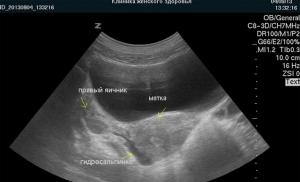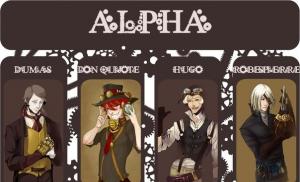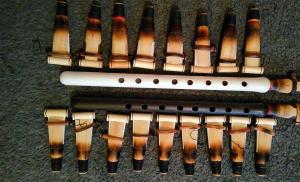Lightsabers, droids and holograms - how real is Star Wars technology? "The Wrong Droids You're Looking For" - A guide to technology in the Star Wars universe Was a lack of intelligence an obstacle for B1.
Fans of the literary and cinematic universe of "Star Wars" today celebrate the traditional "Day of Power", or Star Wars Day.
Since the farewell of the Jedi sounds like “May the Forth be with you” (“May the Force be with you”), which is consonant with the date May 4th in English spelling (May the 4th) - this is how this day of all geeks in love with “Star Wars."
We will not go into the cultural and ideological features of the phenomenon, but let's talk about technologies. Moreover, there is more than enough technology in the epic. And the cycle of film, books, animated prequels and comics on Star Wars has long turned into a separate industry.
Vehicles and combat vehicles
The Disney page on the Star Wars universe generally provides a separate guide to vehicles on planets and in the galaxy where the action of the epic takes place. In addition to large warships (the largest of which can be considered the Death Star, built by Darth Vader, and essentially a planetary orbital station, or an artificial habitable asteroid ship), many small manned ships, automatic battle droids, and ships and walking war machines.
I can see your image well, young padawan.
All communication between the characters and secondary characters in the films takes place through holographic communication, where the main means of communication is a three-dimensional picture with sound (such an analogue of a 3D picture in real life). "Wookieepedia" (analogous to Wikipedia for SW fans) gives a description the main eight holographic technologies. Let's briefly look at the main ones. We hope you are aware of the Old Republic, otherwise the following information may seem a little confusing to you (well, if so, then read Wookieepedia more thoughtfully for all the details).
Hologram A projected three-dimensional image of a being or object, commonly used in communication systems. Works with a range of devices that record, store and transmit holograms using beam scanning. Such an image is either transmitted immediately or stored and subsequently played back through a holoprojector. The projected holographic image is intangible, but it can be observed from any direction. Initially, the holograms were single-color, blue, but after the Clone Wars, some holograms were able to reproduce color information. When operating in the transceiver mode, users of the communication system can see each other's holograms as if they were in the same room, although the proportions may not be respected.

Miniature holograms can be played on portable holoscreens. The communication systems of many starships are also equipped with projectors, they are used by both crew members and passengers. Some droids can also record and play holograms (eg R2-D2).
Holograms could be transmitted immediately or stored on various devices ((such as holodisks) and in droids, including astromech droids. In order to view a hologram, a storage device must be linked to a projector. Many droids had a built-in holoprojector.
Hologram storage devices could be provided with an encryption system if their contents were secret.
The holoscreen was another variant of the holoprojector. This technology is used frequently throughout the galaxy. It displays holo-signals, but instead of projecting them into a three-dimensional image, two-dimensional ones are shown on the holoscreen. It has no weight other than a solid panel that displays the screen. It can be attached to the wall. It is also capable of receiving various types of transmissions.
Not with a lightsaber alone

People who are not familiar with the theme of the series of books and films in the SW universe have the erroneous impression that the only weapons for all the heroes are lightsabers of different colors, which they wave left and right. We hasten to disappoint you: Star Wars is not only lightsabers and blasters, which we remember well from the old films of the cycle.
In fact, the full list (according to the same Wookieepedia) looks like this.
Firearms:

- Ssi-ruuvi Beam Launcher

Steel arms:
Starship and planetary weapons and means of protection:

Sensors and communications:
- Subspace transceiver (transceiver)
Security devices:
- Molecularly Bonded Armor and Shock Field

General purpose equipment:
- Beam drill (drilling rig)
- Harpoon and towing cable
- Jet, rocket and repulsor installations
- Ssi-ruuvi equipment installation
Medical technology in the world of the Jedi and Sith
It would be strange if the Star Wars universe did not have developed medicine with such a level of communications, military technology and transport links. The most well-known example can be considered cloning technology (yes, the episode of the Attack of the Clones film cycle just partially touches on this topic).
Cloning- the process of creating clones, genetically identical or specially modified copies of the original organism. Notable cloning experts were the Kaminoans. One of the more famous and massive projects was the creation of clone troopers for the Grand Army of the Republic shortly before the start of the Clone Wars. The supplier of the genetic material was the famous mercenary Jango Fett, who later participated in the assassination attempt on Padmé Amidala. A special, unmodified clone of him was created for him, replacing his son, Boba Fett.
According to conventional wisdom, it's impossible to create a Force-sensitive clone without going insane. However, cases of such cloning were still known: many clones of Galen Marek, including the one who escaped from Kamino and the Dark Apprentice, Luyuk Skywalker, a clone of Luke Skywalker, or a clone of Darth Vader.
Clones were not only created, but they were also able to heal. However, like other races in that very "one very distant Galaxy." This was done with the help of bacta - a chemical substance from jelly-like transparent red particles of alazhi and kavam bacteria mixed with a colorless viscous liquid ambori. When used for treatment, bacterial particles provide wound healing and rapid tissue repair without scarring. Bacta has often been called a miracle and has been used to treat almost any injury or disease in a vast number of races in the galaxy. Even Luke Skywalker was placed in a jar of bacta.

Droids were not only combat assistants of the Republic and Darth Vader, but also found wide application in medicine. They surpassed living beings in a large amount of information and did not forget anything, which made them very valuable. Meddroids, as they were briefly called, in addition to comprehensive data on diseases, injuries and ailments, could memorize information on hundreds of patients. With the help of a knowledge base and sensors, medical droids could analyze an injury or disease symptoms and automatically determine their severity, prescribe medicines, and indicate side effects. The lack of emotions in such droids was both an advantage and a disadvantage: feelings did not interfere with the task, but the patient felt indifferent to him from the machine.
These droids could also perform procedures and operations themselves using built-in tools. The attachments on the manipulators were often easy to change, allowing for quick switching from one area to another (for example, from neurosurgery to pediatrics). Due to the high cost of complex med droids, some series (such as the DD-13 or FX-7) had a simplified design and were often used as assistants. They had independent functionality, but were designed to work in conjunction with more complex models of meddroids.
In addition to nozzles and manipulators, SW appears in medicine vibroscalpel- a medical tool that was used to attach severed limbs back to the body. You yourself understand that when everyone around is waving swords left and right, keeping arms and legs intact is another task.
But in the event that it was not possible to sew an arm or leg back, it was used synthetic flesh- synthetic material, to provide emergency medical care before the arrival of doctors. It was very similar to synthetic leather and was used to cover prosthetic limbs such as Repley Limb Prostheses.

Repli-prosthetic limbs were incredibly lifelike replacement prosthetics, designed not only to be identical to the original limbs, but with comparable functionality. Replica Prosthetic Limbs not only range from arms and legs, but also include eyes, ears, hearts, and lungs. In addition, the prostheses themselves can be renewed many times over, allowing them to function much more efficiently than the organ that was lost. Prosthetic limbs can often be covered with synthetic flesh to hide their artificial nature.
Galactic Technologies
And of course, the most interesting component is the technology used in space travel. Since the distances between planets and systems in the Galaxy were rather big, then hyperdrive or hyperdrive was used for movement- a vital part of the starship, allowing the ship to enter hyperspace and cross vast distances faster than the speed of light. Thus, the hyperdrive was one of the key technologies in creating interplanetary communication, trade and war. Its design and operation principle was based on the hyperdrive theory. The term was used to describe the engine and all of its components needed to use it, such as the motivational hyperdrive and the control hyperdrive.
The hyperdrive is made up primarily of an alloy of titanium and chromium, which was developed specifically for hyperdrive. It gave ships the ability to withstand the constant impacts caused by travel between the dimensions of real space and hyperspace.
Hyperdrives allowed travelers to traverse a galaxy more than 120,000 light-years across in just a few hours or days, the exact travel time depending on a number of factors: destination, departure point, route, and hyperdrive class.
For flights over shorter distances, twin engines were used. Dual ion thruster was a sublight engine used in the starfighters of the Sith Empire and the Galactic Empire.
The principle of operation of the engine in the acceleration of charged particles to relativistic speeds in an electromagnetic field and their subsequent emission. At the same time, particles could be emitted in almost any direction, which made ships using such an engine extremely maneuverable. A unique feature of the engine was its incredibly high specific impulse, which made it possible to use the fuel extremely efficiently. In addition, the absence of moving and high-temperature parts made the engine very reliable and unpretentious.
Planets that colonists and armies discovered and wanted to make habitable were subject to terraforming or zenomorphing. This was the name given to the process of turning a previously uninhabited planet into a habitable planet for certain races. The Rakata, during the time of the Infinite Empire, were the first known civilization to develop terraforming technology and build machines to do so.

Speaking of machines and the reliability of materials in the SW universe. One of the most common materials among races and planets was durasteel. Even a very thin sheet of durasteel was able to withstand heat, freezing cold and great physical exertion. Because of these features, durasteel has been used almost everywhere, from smelting furnaces for other metals to the fuselages of spaceships. Durasteel containers were widely used throughout the galaxy. The only serious disadvantage of the alloy was that it could rust. By the way, the armor of Darth Vader almost entirely consisted of durasteel.
The second strong base for armor was quad steel. The surface of the first and second Death Stars were made of Quadanium steel.
About other technologies in the Star Wars universe can be read in a special section of Wookieepedia.
Industry and Star Wars in real life
It is worth saying that in addition to its value as a literary, cinematic and cultural phenomenon, Star Wars has also become a kind of technological prophecy for humanity. Films shot in the 70s and 80s of the twentieth century demonstrate technologies that were already created in the late 90s and early 2000s.
Video communication using Skype and similar technologies is gradually transforming. And soon the hologram featured in Star Wars could well go from fantasy to reality. Austrian scientists from the TriLite Technologies company prototype a giant screen that, using laser beams, shows a three-dimensional image. For portable devices, the Japanese corporation Toshiba, on which the user does not need special glasses to view a three-dimensional image.
But the lightsaber is not very good so far: back in 2013, the first experiments were carried out to obtain, which was supposed to form the basis of a light weapon. Then a lightsaber based virtual reality. And only lone enthusiasts were able to demonstrate real examples of such weapons. An American fan of the Star Wars movie epic of the laser sword, which the Jedi Knights fought in the movie saga.
Blasters and combat laser guns, which were owned by Han Solo, the rebels and Chewbacca - does not seem to be such a fiction. The Israeli company Rafael Advanced Defense Systems has introduced the Iron Beam laser missile defense system - it is flying at a distance of up to two kilometers. Chinese engineers of a laser system for intercepting unmanned aerial vehicles at low altitudes. An AV system from Lockheed Martin called ADAM passed a series of tests, effectively.
Drones from the future long time in reality. And the systems of high-precision weapons, wearable electronics and personal protection are not "clone armies", but quite real armies of the planet Earth.
similar to Darth Vader costume, - also no longer a subject for fantasy. The US Defense Advanced Research Projects Agency, better known as DARPA, is a flexible robotic exoskeleton that soldiers can wear to increase strength and resilience. Also the command of the US Army TALOS Hollywood company Legacy Effects, which specializes in creating special effects. Combat tests for 2017.
Synthetic fabrics and bioprosthetics- another sphere that the creators of the SW universe predicted. For example, the Enhance Your Eye (EYE) project uses a 3D bioprinter with a special needle to create complex cell constructs. Modern bioprinters are already printing ears, blood vessels, kidneys, are now underway. Volumetric printing helps to create organs. And researchers from the University of Tokyo Hospital, which can produce human skin, bones and joints.
Robots in medicine and applied biocybernetics are finding wider and wider. NASA Robonaut 2, through which in the future it will be possible to treat people in space.
Heavy-duty materials are also gradually becoming a reality- and piece objects, and in mass production. Thus, the German company AMSilk has developed a heavy-duty web-based material, and is preparing to start mass production. Synthetic spider silk several times. Japanese company Sekisui Chemical, which has the strength of steel, but is much lighter than it. And the engineers of Pohang University of Science and Technology, South Korea, which has the same specific strength coefficient as titanium, but costs 10 times cheaper.

As you can see Strength is truly everywhere.- it is only important to apply the achievements of science and human knowledge in order to put it into practice. And remember: don't go to the dark side, even if they promised cookies (because in the Star Wars saga, the dark side ends up losing).
Lightsabers, droids and holograms - how real is Star Wars technology?
In contact with
Classmates
The Last Jedi is the eighth episode of the cult sci-fi saga Star Wars, notable not only for its detailed world, but also for technology on the verge of reality and fantasy.
Needless to say, in Star Wars, which is based on several protracted conflicts, technology is mostly shown in a military context - but there are also many "peaceful" inventions. Rusbase tells how far we are from the level of development of one galaxy far, far away.
lightsaber
Let's start, of course, with the Star Wars icon, the lightsaber, "an elegant weapon from a more civilized age," as Obi-Wan Kenobi said in A New Hope. The lightsaber, when activated, releases a blade of "pure energy" (a widespread misconception that the sword is a laser), which is multiplied by the kyber crystal - the main element of the weapon, which gives the blade color. Subsequently, large kyber crystals were used to create a superlaser for the infamous Death Star.
What's in reality? They have been trying to make a lightsaber for a long time, but no one has achieved full success. Since the nature of the "pure energy" that makes up the blade of the sword remains a mystery to us, all attempts are reduced to creating a sword based on a laser. And the main reason for the failures is that there is still no technology capable of fixing the laser in space: it will simply last until the nearest obstacle, gradually losing its power. And, of course, there is no such source that would fit in a small sword handle, but release enough energy so that the laser can burn through solid matter.
Droids
There are so many droids in Star Wars that you literally stop noticing them. Most of them have a very strong artificial intelligence, moreover, some are endowed with a high level of autonomy and even self-awareness. And although droids are still treated more like things, you sympathize with some more than living creatures.

In the real world, we do not have such a general term as a droid, but there are various robots, drones and drones, household robots (for example, a robot vacuum cleaner) and hundreds of different robotic units designed for fairly narrow purposes. Their artificial intelligence consists of algorithms aimed at solving certain problems, and is devoid of autonomy and creativity. The design of robots in the usual sense also does not stand still, as a well-known company constantly reminds us of.
More curious is the problem of artificial intelligence and its perception by humans. We have the ability to endow AI with computational power, but it is much more important (and more difficult) to instill in it the ability to think non-linearly. Of course, there are successes in this part, it is enough to recall the development of neural networks.
Various games are also a testing ground for AI capabilities. In 1997, Garry Kasparov lost to the Deep Blue supercomputer developed by IBM. In 2015, the artificial intelligence AlphaGo created by Google DeepMind won against the three-time European champion Fan Hui, and in 2016 against one of the strongest Go players, Li Sedol. In both cases, computers were recognized as stronger than live players, which actually puts an end to the confrontation between AI and humans in these disciplines.
After that, DeepMind developers turned their attention to computer games. The created neural network must now learn how to win a person in StarCraft II - this is a real-time strategy that combines the management of the economy and various troops from Blizzard. And here the AI is far behind, because the player needs to act somewhat blindly: the enemy is constantly hidden by the so-called fog of war. It is necessary to predict the actions of the opponent, which AI cannot do due to the lack of initial data. This is where StarCraft differs from chess or go, where AI can see and analyze the whole picture of what is happening. According to the developers of the game, StarCraft II is an ideal environment for the development of artificial intelligence, as the complex rules of the game reflect the "versatility and chaos of the real world."
So far, DeepMind has not been able to beat even a weak bot, but the experiment is just beginning: DeepMind agreed with Blizzard to work together on AI, and also connected ordinary players so that the neural network had material to work with.

In Star Wars, droids also played games quite successfully - R2D2 beats Chewbacca in the local equivalent of chess. A scene from the film A New Hope.
If we talk about the self-awareness and emotionality of robots, then it is worth mentioning voice assistants that not only recognize human speech and can support a simple conversation, but also give emotional overtones to the remarks.
One of the most "human" representatives of artificial intelligence is a robot. "Sofia", which also has a physical form, thanks to which it can reinforce its replicas with facial expressions and gestures.
Although the set of her facial movements is very rich, looking at the mobile face of "Sofia", one involuntarily recalls the effect of the "uncanny valley". It is noteworthy that in Star Wars, humanoid droids, as a rule, are completely devoid of facial expressions and have sketchy facial features, but this does not prevent them from expressing their emotions quite accurately.
Anti-gravity thrusters
Much of the technology in Star Wars uses anti-gravity thrusters to fly above the surface of planets. Of course, this makes transport almost all-terrain, and the average speed of movement increases greatly.

Trade Federation tanks on anti-gravity engines. Shot from the film "The Phantom Menace"
In reality, we, unfortunately, do not have such a technology, because the very concept of using gravity still lies beyond the boundaries of reality. The only analogue of such an engine can be considered a technology based on magnets and superconductors cooled by liquid nitrogen, which Lexus engineers implemented to create a hoverboard (such as in the movie Back to the Future) back in 2015. The device needs to be frequently refilled with liquid nitrogen, and can only be used on a special surface, which makes the technology very expensive, although viable. Also, several companies (including the Russian Hoversurf) are developing a hoverbike that works by propellers that create an air cushion effect.
Force field
A force, or protective, field in Star Wars is usually an energy dome that protects everyone under it from energy impact, fire or blast - but not from physical impact. Since almost all weapons in Star Wars are energy weapons, the force field is a serious protector.

Since there are no blasters in the arsenal of real troops yet, but there are conservative metal bullets and shells, the force field in any case could not become a universal method of protection. A different situation with protection against explosive waves. The Boeing Corporation decided so and patented their own force field, which functions a little differently than science fiction. In the event of an explosion near the transport, the protective system instantly calculates which side it occurred from and sends a pulse there, which ionizes the air, forming a field that partially absorbs and partially reflects the blast wave.
It is worth adding that patenting does not mean bringing an idea to life. Tech corporations often patent high-profile inventions, either for PR or to get ahead of competitors in the future - and more than a dozen futuristic projects are gathering dust in the patent office.
bacta chambers
Bacta chambers in Star Wars are filled with bacta, a jelly-like transparent substance capable of quickly regenerating tissue and healing serious wounds, as well as treating various diseases.

Luke recovers from his wounds in a bacta chamber on the planet Hoth. Shot from the movie "The Empire Strikes Back"
The very image of the bacta chamber was created on the basis of an isolated sensory deprivation chamber - a dark soundproof tank with a dense solution of salt water, invented in 1954 by the American psychoanalyst John Lilly.
As for the miraculous substance itself, synthetic skin is currently being developed, which greatly enhances tissue regeneration. The patent was inducted into the US National Inventors Hall of Fame in 2015 and later released by Integra LifeSciences Corp as the IntegraTM product. And scientists from the Cedars-Sinai Medical Center are working on the creation of a special agent based on bacteria that will accelerate the fusion of human tissues, including bone.
Holograms
In Star Wars, almost all images are transmitted as holograms - and can be either static or dynamic. Images are projected and recorded through the holoprojectors found in most vehicles, droids, and rooms; also projectors exist in the form of small portable devices.

Although holograms are still perceived as the technology of the future, in fact, they are already on the threshold of our daily lives. Of course, they can't be used as easily as shown in the movie: as with a lightsaber, the light a hologram creates cannot be fixed in the air - it won't create an image if it has nothing to bounce off of.
But there are holograms that work on a different principle: back in 2012, Snoop Dogg spoke on the same stage with a hologram (actually a projection) of rapper Tupac, which was created by Digital Domain Media Group.
Many startups are trying to create a three-dimensional hologram in space, one of the most advanced at the moment is a startup with Belarusian roots Kino-mo, which won the 2016 Pitch to Rich competition held by Virgin Media. It does not create a hologram in the full sense of the word, but rather an image with a 3D effect, which, nevertheless, looks impressive.
The regular infantry droids in the Star Wars prequels and The Clone Wars series are as dumb as rocks. They are constantly confused, deceived and deceived by thin paper schemes when they do not stumble over trouble. Even more advanced droids such as assassin droids, protocol droids, and astromechs such as C-3PO and R2-D2 are highly intelligent and are referred to by Obi-Wan as "dimes" ("Fall of the Droid", The Clone Wars 1-6). ). Is there an in-universe explanation for why the Separatists don't provide the droid infantry with better programming?
vastra360
Please, no extraterrestrial explanations. I understand the motivation to go for cheap laughs in media that is sold primarily to children.
DVK-on-Ahch-To
Canons need to be hunted, but IIRC they are for central AI/mainframe control (aka Dumb Terminals:). Except that the practice ended the post-Nanakin destruction of the central computer on Naboo. In addition, they did not need smarts - Revenge of the Sith: The Visual Dictionary claims that there were a huge number (quintillions). Remember the T-34 against late heavy Nazi tanks.
Triton scamander
Are you talking about B1 battle droids?
vastra360
Yes, thanks for the correct notation.
vastra360
Just curious, can anyone explain the reason for the downvotes?
Answers
Thaddeus House
B1 battle droids are less intelligent because they didn't need to be smart, nor were they designed to be. In fact, they were originally designed to coordinate with the Droid Control Ship, which would coordinate and direct their strategy, firing patterns, and overall tactical movement.
Role of the B1 battle droid in combat
The B1's role in combat was to keep blaster fire aloft, absorb damage, and contain incoming fire until more powerful and dangerous droids could be deployed.
After the Battle of Naboo, the control ships were considered problematic and potentially vulnerable, so the B1s were forced to be semi-autonomous, causing them to behave erratically. Not every B1 battle droid was unstable, some thanks to better programming could be leaders, commanders, or even commando droids.
To complement their capabilities, super battle droids were created. Super Battle Droids and Droidikas were much more powerful, adaptable and smarter. Like any other specialized force, with the right support, in this case thousands of B1s, these specialized droids can be used to devastatingly affect enemy troops.
Was a lack of intelligence a barrier to B1?
B1 battle droids didn't need to think, and weren't originally designed to think. They had leaders, handlers, or control software to direct their movements to whatever terrain they found themselves in.
The B1 battle droids were designed to respond to feedback from the environment (other troops, terrain, and whatever weapons they have) to destroy their enemies. They didn't have to be particularly smart, their machine programming was more than adequate for most of their missions and could be updated over time.
What the B1 battle droid lacked in intelligence, they made up for in superior numbers. When fighting live enemies, B1 would be a terrible opponent if for any other reason their ability to just absorb damage and keep pushing forward.
If B1 and the other droids arrived in the right numbers, it would take a force with a significantly larger power profile to stop their advance. Even adding Jedi to the defending force was often no guarantee of survival for the defenders.
Say what you like about the supposedly idiotic B1 battle droid; on the field, they were able to keep the rain of blaster fire from the enemy, suppressing their movement, tactics, and fire, allowing the stronger droids to get closer, charge into the defenders, and simply allow the B1 to burst through whatever hole was created. It's simple in terms of strategy, but like the army ants, the B1 battle droid used it quite effectively.
vastra360
This answer makes a lot of sense to me as droids are inefficient because they all function in the conditions they were designed for. Thank you.
joshbirk
And how is this different from my answer? I will summarize exactly the same conclusion and offer more detail. So why is this the accepted answer?
vastra360
Because his reasoning is different and more understandable. Your main argument is that they are cheap, apart from Anakin's influence on the control computer on Naboo. The main point of Thaddeus is that they are dumb because they are forced to work without one of the main components of their original design (centralized direction)
vastra360
More information doesn't make for a better answer unless it's deployed to a credible argument in an elegant way. And, like the OP, a decision that is trustworthy unfortunately falls on me.
joshbirk
And I should point out that I don't think Thaddeus is making that argument. He seems to be using Control Ship as an example that they were designed to be basic grunts from day one. It's not that their efficiency or general intelligence differed from each other.
joshbirk
Because they are cheap and expensive
A lot of them :
B1s were perhaps the most numerous and expendable soldiers in the history of the galaxy, and unlike most organic soldiers, they were capable of operating in hostile environments such as underwater or in space. They were designed, for the most part, to defeat their enemies with mere numbers rather than their ability to think (they were very vulnerable to subterfuge) and use combat skills (unlike clone troopers).
To get more out of them, they were almost certainly made from cheaper parts. Slower processors, less memory, etc. In modern parlance, they are stupid for the same reason that the $299 Dell's specialty Dell can't run crysis just like a $4,000 gaming rig.
AT " Innocent Ryloth" Ahsoka comments on this:
“Remember, they are droids. They are a little slow."
Their less mass-produced predecessor, the OOM series, was smarter:
The OOM-series battle droid was the predecessor to the B1 battle droid. Although physically identical to the latter, the OOM series featured more advanced and independent programming. They were already a common sight in the galaxy prior to the invasion of Naboo, serving as guard and command for the Trade Protection Force. They later served in the Clone Wars alongside their more common but simpler B1 descendants.
And during the Clone Wars show, we also see that there are more capable commando droids out there. They are designed for stealth, a handful of them can take down a soldier's outpost... but vice versa:
The only real downside to these droids was that they were much more expensive to manufacture than regular infantry. This made droids a fairly rare sight on the battlefield, and thus allowed them to be used exclusively in special and/or critical missions. Apparently, the head was weaker than the rest of his body, as Senator Amidala could easily kill one by shooting the head with an ELG-3A royal blaster pistol, which was little more than an off-the-shelf blaster.
So we see a pretty consistent trend that the more common droids are, the cheaper they are... and the dumber they are. As to why droids often act strangely, like talking to each other while trying to shoot Jedi... that's how all droids in the Star Wars universe work. For some reason, droids in Star Wars have personalities, not just protocol droids. Why does the MSE "mouse" droid "run in fear" at loud noises?
It may not make logical sense, but Droid AI works in the Star Wars universe nonetheless... this behavior is not uncommon.
As for being "constantly confused, deceived and fooled by paper thin schemes" - this usually happens when droids don't do what they're good at... which forms a huge army and kills things. As a standing army, they are pretty good. Remember that the droid army:
- Would have won the Battle of Naboo if the central computer hadn't been destroyed. After that, the reliance on the central command computer was removed.
- They pose enough of a threat that the Republic should start mass-producing clones.
- Repeatedly in The Clone Wars, we are reminded of just how close war is...deals with the Hutts and Rodians, only in the first season, are portrayed as vital. As stupid as they are, droids remain a threat to Clone armies of Jango Fetts, one of the most capable soldiers in the history of the galaxy.
They are stupid. They are, however, effective. When used as directed. And while it's true that they seem to fail as guards, they're often portrayed that way when they look at the jedi knights. A good example of this is "The Hidden Enemy" where:
Anakin, Obi-Wan and their clones prepare to ambush the advancing droids from the two towers. Just as they are about to fire on the droids, the advances are divided into three columns and the droids suddenly appear in Obi-Wan's building. Anakin calls the gunship for immediate evacuation before dispatching his crew to help Obi-Wan. They run to the rooftop with the droids following them. Their gunship arrives, picking them up, but not before taking the tactical command droid's head to find out how the Separatists discovered their plan.
In the opening scene, we see the B1s being used correctly - accompanied by a tactical droid, they nearly overwhelm and defeat a squad of clones and two Jedi. This is a big threat. They are not made to be smart - they are made to follow orders, walk in columns and keep shooting.
However, I can't answer why Separatists don't rely on more human/intellectual assets for roles that require more individual tasks (this is where B1 usually falls short).
DVK-on-Ahch-To
FYI: This Wikia article is quite thin, so quoting from it is questionable even in canon.
vastra360
For example, you never see droids fail because they freeze or take too long to sort out the situation. They usually act like dumb, irresponsible, stupid soldiers, but their computers aren't slow. (My understanding of canon isn't great, but I don't think I've ever seen the script " blue screen of death" which makes them screw up)
vastra360
My main point is that the "cheap=dumb" argument doesn't refer to the type of stupidity they are. It's not that they're slow or that they're only programmed for a limited number of scenarios. The fact is that they are programmed extremely poorly.
You don't know how much cheaper transportation is than artificial intelligence. It seems that in the SE Universe, the movement of huge masses in space does not seem to be a big problem.
ace
They were disposable and used to make cannon fodder because it was politically sensible; no one cares about droids going to war, as opposed to whether their sons or fathers are killed and killed.
They are also cheap and very effective. Sometimes the enemy doesn't need a smart opponent, but a relentless, overpowering, overwhelming one, which is what droids do in huge numbers. Smart and smart means nothing with a control ship around.
It also gave Palpatine the perfect opportunity to use clones: "but they are smarter and much more efficient than just dumb droids..."
IG_42
In short, the Trade Federation is complete cheap stingrays, droids have a minimum level of quality in construction, equipment and intelligence. Leading them through control ships is another example of cost savings while having an obvious military objective is the easiest way to manage an army.
as a personal opinion, I think it's doubtful that the Trade Federation actually originally used the B-1 with actual war in mind, instead relying on pure numbers to intimidate enemies or in case Naboo chose what was considered an easy target. Also, by the time the Clone Wars began, they certainly had super battle droids to fight more serious battles, so by the end of the war the B-1s were mostly relegated to ships instead of combat.
Corey Watchman
I think this has been stated before by several people, however I am going to emphasize it again. Droids in SW canon behave in a unique way. They seem to have human qualities in them. They do, however, fall prey to bad programming (especially on B1, which we're talking about too).
If we look at arguably the most destructive battle droid ever conceived, the droidek, we can see that it is used in incredibly small numbers. For example, this is seen twice in ROTS and once in AOTC. Obviously, a droid with the ability to hold itself in a shield would be costly, and so field armies are not made entirely of them. As such, costs will play a role in the development of the droid, which is why B1 (and to some extent the more enhanced B2) have trouble making decisions.
There are no decisions on the field, they follow the directions of a pre-set battle plan or the decisions of a command/tactical droid. The only scenes where they are ever distracted and embarrassed are the scenes where they have to make decisions because something is out of the ordinary; like the Jedi escorting the pilots in Naboo's hanger, or Obi-Wan and Annikan going up in an elevator full of security droids. As a raw recruit, they must first consider for themselves whether they need to take action and what action to take. That's where their lack of memory and processing power falls there. It also brings us back to the human features worn by droids in Star Wars.
Droids don't follow the same rules our robots and AIs follow, which would seem like "competent computing power" in our world - a flaw in the Star Wars universe. Why do droids fuss and stumble, why do mouse droids run away from loud noises, why do pit droids (or whatever they are, big nose droids in the Phantom Menace subrace scenes) laugh and get annoyed at each other, and why C3-P0, protocol droid talking about mistreating his astromech droid friend? These are the traits that distinguish droids and AI in Star Wars, and that seems to answer half of your question. Droids, especially B1, have negative and comical human traits.
Jeff
Hello and welcome to the Sci-FI Stack Exchange. I have corrected your answer to improve spelling, punctuation and capitalization. I hope I haven't changed any of your intentions, feel free to come back if I haven't improved it.
Maxi
Battle Droids are supposed to be ineffective in terms of storytelling. We needed to see the evolution from Battle Droid > Clone Trooper > Stormtrooper. Palpatine uses CIS infantry because of the sheer amount of resources and then disposes of them when the time is right.
Valorum
OP looking for an answer in the Universe .
old cat
What evolution? All three of them were completely ineffective in combat. What stormtrooper hit something??
Droids are an important part of the Star Wars saga. They embody good and evil, helping the main characters or fighting against them. In today's article, we'll take a close look at the best movie droids, without which they wouldn't be possible. Droids are taken from all episodes, including the animated series and comics.
#10: AZI-3 ("The Clone Wars")
In Mission Lost, we see this robot evolve from book medical droid to risky fighter. Assigned to expose the mysterious murder of the Jedi, AZI-3 uncovers a terrible secret that all clones have a hidden artificial brain tumor. According to the clones, the tumors are meant to keep soldiers restrained when needed; in effect, they are repeatedly forcing the killing of the Jedi. AZI-3 risks everything to help another clone of Fives with his search for the truth. He helps avoid Fives' detention and performs illegal surgeries to remove the bias's tumor. Since this is not enough, it turns into a very cool high-speed bike hovering over the water. AZI-3 is the perfect example of a droid with a personality and courage that goes beyond their programming.
#9: 2-1B Surgical Droid (Star Wars & The Clone Wars)

The 2-1B surgical droid is one of the most famous droids in Star Wars. He mainly specializes in repairing Skywalker. He also heals Luke in a bacta tank on Hoth, provides the young Jedi with a cybernetic arm, and thus performs an operation to save Anakin after his duel with Obi-Wan Kenobi. The model is very often present in The Clone Wars, helping injured clones and Jedi, and his instantly recognizable face is one of the more unique droid designs.
#8: Saw Droid (Revenge of the Sith and The Clone Wars)

Perhaps the most disgusting of all the Star Wars droids.
The saw droid hooks onto ships, shutting them down or tearing them apart, swarming and communicating like insects. As seen in "Revenge of the Sith", mechanical droids threaten to attack Obi-Wan's starfighter, ripping off the roof of R4-P17 and damaging the Jedi ship. When they become weak, saw droids with inventive weapons become incredibly effective.
#7: IG-88 ("The Empire Strikes Back")

One of the select bounty hunters chosen by Darth Vader to find the Millennium Falcon is IG-88.
It is one of the deadliest droids in the galaxy. Despite his limited time in The Empire Strikes Back, the droid had a big impact on how the movie was received. With intimidating red eyes and an unsettlingly quiet demeanor, IG-88, who is one of the first Star Wars villain droids, has shown that not all robots are meant to serve humans.
#6: Battle droid (Star Wars and The Clone Wars)

They are dumb, inept, and easy to kill with a sword. But battle droids play a huge role in the saga.
As the main military force of the Separatists, they act as a symbol of aggression and terror, protecting clones and stormtroopers. While battle droids are often used as comic relief, they pose a significant threat to the Legion, being simply heartless machines.
#5: Probe Droid ("The Empire Strikes Back")

With spidery legs, retractable antennae, and large eyes, the Probe Droid is the perfect representative of Imperial tyranny.
Robots first appeared in The Empire Strikes Back and have easily traveled across the galaxy in every Star System, being able to self-destruct an enemy even if they themselves explode in the process.
#4: Droideka (Star Wars and The Clone Wars)

A Jedi can kill battle droids without difficulty. But with Droidek, things are not so simple. With a frightening insect form, they create impenetrable shields, heavy fire blasters and march fearlessly towards their targets.
Their downside is their lack of dexterity, but they can be used with weapons and are designed to hit. And they do it very well.
#3: Huyang (The Clone Wars)

Showcased in Star Wars: The Clone Wars, the Huyang has become one of the saga's most popular droids.
The ancient and wise Huyang has assisted in the creation of Jedi lightsabers for centuries. He helps build parts to support the massive Jedi population and assists young designers in building the GungiWookiee, a wood-infused lightsaber.
#2: C-3PO ("Star Wars" and "The Clone Wars")

He has been called the "stupid philosopher", the "golden rod", and the "Professor". However, C-3PO has one of the biggest meanings of not just being a droid, but being the symbol of Star Wars.
He has real inner strength and heart, being an integral part of some of the most important events in the galaxy, in particular the transmission of Obi-Wan Kenobi's secret message to Leia to save Han Solo. Threepio volunteered to give his parts to a severely damaged Art for sabotage on the Death Star and Endor to help his friends, and upon seeing a stormtrooper in Cloud City, he immediately alerted his comrades. Not bad for a droid programmed only for etiquette and protocol. In addition, he receives bonus points for being an Ewok god.
#1: R2-D2 ("Star Wars" and "The Clone Wars")

R2-D2 is like no other droid, being a comrade, a leader and a hero at the same time.
Watch the highlights of his journey: rescuing the Naboo Royal Ship, destroying two super battle droids; moving stolen plans from the Death Star to Tatooine; and setting up a final cover in Jabba's palace. Artoo is filled with hidden compartments and fun gadgets with a bit of mystery added to it, and its overall design is still original and iconic. In addition, Artoo is the most human of all droids. He is worried, sad and may be afraid of something or, on the contrary, be brave. But no matter how he feels, Artoo is always loyal, completely selfless and ready to take charge like no other. Therefore, it is simply impossible to imagine Star Wars without him.
These were the brightest and most prominent droids from the Star Wars saga. You know that the new part of Star Wars: The Force Awakens is coming to the screens soon, and we will hope to see even more new heroes and amazing droids in this film.
Look forward to new interesting articles from the world of robotics in our next issues and may the force be with you!
P.S. Bonus video! C-3PO and R2D2 meet the droid BB-8 from the new episode 7 of Star Wars: The Force Awakens













